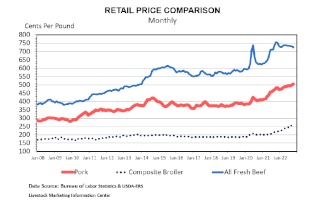By Dr. Kenny Burdine
I open a lot of my Extension programs by showing the retail price chart seen below and discussing general trends in production levels for our three main meats (beef, pork, and chicken). By the end of 2022, pork production is going to be down year-over-year and the increase in broiler production is going to be relatively small. Beef production will actually be a little bit higher than last year, primarily due to very high cow and heifer slaughter. However, that trend is likely to reverse in a big way for 2023 and we should see a reduction in beef production of 5% or more.

As I walk through this discussion, someone in the audience will sometimes ask something like, “given that retail beef prices are already very high, and production is likely to get even smaller next year, will retail beef prices get so high that consumers move away from purchasing beef at the grocery store?” When this comes up, the person asking the question is genuinely concerned that beef could price itself off the average plate. I thought this idea would be worth discussing in this week’s article.
I want to begin by looking at this question from a slightly different angle. The question comes from the perspective that price is fixed and price is what determines consumption levels. At the individual household level, this is largely true. A consumer makes purchase decisions at a retail location based on the prices they see. If the beef product they wanted was higher than expected, and a better buy was perceived to be had on another product, that consumer may well choose to purchase a competing product. But, I like to think about this from more of a macro perspective.
Most economists would argue that consumption is primarily a measure of production levels, and those production levels are largely fixed in short run. The number of cattle on feed, and the eventual number that are harvested, really determine beef production for a given time period. That level of production will either be consumed domestically or exported. So, beef production really ends up determining how much beef is consumed in a given period of time. If beef consumption isn’t keeping pace with production, retailers and restaurants will adjust prices upward or downward such that the market clears.
If we go back to that individual at the grocery store, they may well purchase something different that week if they perceive beef prices to be too high relative to other products. If enough people do that, the retailer is sent a message and they have to adjust those prices in response. And this occurs at retail locations all across the county. Consumers send messages through their purchasing patterns. By looking at it this way, prices become a reflection of consumer willingness to pay for beef. If beef production increases, the additional beef will be consumed. The question really comes down to what price level is needed to absorb the additional production. And if beef production decreases, prices likely have to adjust upward to ration out the tighter supply levels.
I walked through this simply to say that I view price as the more fluid element of this discussion. If retail beef prices are high, it is likely a reflection of the relative value consumers place on beef. If retail beef prices get “too high” consumers will respond and the prices will adjust accordingly. While price may determine consumption at the household level, I would argue that consumption determines price at the overall market level.
Source : osu.edu